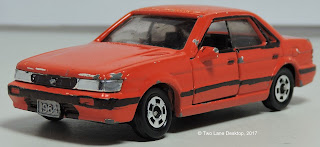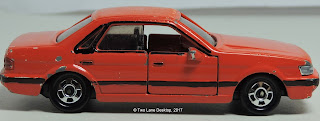Playart Isuzu 117 coupe, Tomica 1989 Nissan Bluebird sedan, and Majorette Toyota Tercel 4WD “Breaking Bad” edition
Here are a trio of vehicles that each have a unique touch of their own, one
being a famous T.V. star, and despite being made by different diecast
manufacturers all share the same common Made in Japan purpose.
Majorette Toyota Tercel 4WD “Breaking Bad” edition
Let’s get this one quick out of the way since I already profiled the
Majorette Toyota 4WD wagon in a previous post.
Majorette made lots of colors of this Tercel wagon, a special 4WD
version called the Sprinter Carib in other countries and was a very unique
offering for Toyota at the time. Out of
all of them this red one is the most important as it was Jesse Pinkman’s second
car in the AMC T.V. series “Breaking Bad” and it was this series that spiked
interest into this diecast replica. I
managed to find a red one in playworn condition so in addition to the added
detailing I also blacked-out the spoke wheels to match the black steel wheels
on the T.V. car. I also had to clean out
the interior because it looked pretty yucky in there; overall the car is now a
T.V. star and the casting itself is a unique piece with working suspension,
stylish wagon profile, and rear hatch that opens to the cargo area and not to
forget the trailer hitch for towing.
Playart Isuzu 117 coupe
Here’s another unique playart with one thing I never seen on a Playart
casting before: metallic purple paint.
Too bad it was playworn to really show the color off. Isuzu is well-known for its trucks and SUV’s,
but at one point they did make cars. One
of them is the stylish 117 coupe pinned by Guigiaro and is Isuzu’s four-seat
gran turismo sports car. The look is
similar to comparable sports cars of the time with a sleek fastback roofline
and lowered stance with slightly-canted down headlights. The interior offered seating for four with a
typical right-hand drive dashboard layout.
The engine is a 1.8L DOHC I-4 with the first use of electronic fuel
injection to produce an estimated 110 horsepower through a 4-speed manual
transmission. The sleek coupe lasted for
almost two decades before a General Motors alliance in the 1980’s booted the
117 for a modern Piazza coupe.
The look of this car is pretty striking even for a basic Playart design
despite the sagging rear axle, missing rear bumper, and playworn paint of my
example. The front has a chrome grille
with four large round headlights and a cross grille connected to the lower
front bumper. The sides show off the
sleek fastback look and Playart wheels, though there are no opening doors and
to conceal the massive paint chips on the roof I gave it a black vinyl top
design. The rear has slim rectangular
taillights and this is the point where Playart coupe castings tend to look
similar to one another (see the Fiat Dino for a good comparison). The base is painted white instead of the
usual black, while the interior has nice tan colored seats with black
dashboard, but again it lacks any detailing.
There are finer examples of the 117 from Tomica, but no one can match
the classy nostalgia of this Playart casting.
Tomica 1989 Nissan Bluebird sedan
We all know the popularity of the Bluebird sedans of the 1960’s and 1970’s,
but what about the latter models? In the
case of this 1989 front-wheel drive version not so much, but thanks to Tomica
they are out there. The U11 generation
in 1983 saw the introduction of the first front-wheel drive Bluebird and by
this U12 generation in 1987 with a more modern and aerodynamic look of the
previous-generation and shared some styling characteristics with the Nissan
Maxima though both were completely different vehicles. In the U.S. it was sold as the Nissan Stanza
and this would be the last-generation of this styling as the next-generation
went for a more rounded look and for the U.S. a new name: Altima. Four-wheel drive was offered for the first
time and all models were four-cylinders to separate from V6-powered Maxima’s. The engine is a 2.0L DOHC I-4 that produced
an estimated 150 horsepower to a five-speed manual transmission; the interior
has a more modern look at the time that cleaned up the crude design of the earlier
1980’s versions.
The orange of this Tomica casting stands out and looks pretty good for a
1990’s Nissan sedan despite a few paint chips here and there. The front has chrome headlights that wrap
around the corners and connect to the center grille, while adding black trim adds
interest to the front bumper with 1964 plate.
The sides have typical sedan profile with 5-spoke skinny Tomica wheels
on a working suspension, while the rear has oval taillights that connect to the
trunklid with a red bar. The interior is
accessed through opening doors and show off some impressive touches for a
Tomica at the time: the front seats have supportive bolstering, there is also a
rear seats, while up front there is the usual Tomica detailed steering wheel
and missing dashboard, but look close and you can see the center stack controls
that flow up from the floor shifter.
While not as popular as the original 1960’s Bluebirds this 1989 version
looks pretty sporty for a typical modern 1990’s sedan.











































Comments
Post a Comment